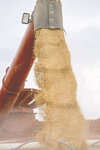Clear, 49° F
In so many words, the pledge was made: “If we need more barley, we’ll buy more.”
That was the declaration by Ryan O’Toole, president and COO of Briess Malt & …
This item is available in full to subscribers.
The Powell Tribune has expanded its online content. To continue reading, you will need to either log in to your subscriber account, or purchase a subscription.
If you are a current print subscriber, you can set up a free web account by clicking here.
If you already have a web account, but need to reset it, you can do so by clicking here.
If you would like to purchase a subscription click here.
Please log in to continue |
|



In so many words, the pledge was made: “If we need more barley, we’ll buy more.”
That was the declaration by Ryan O’Toole, president and COO of Briess Malt & Ingredients Co, in a letter to area malt barley growers last April, invalidating 2020 growing contracts due to unforeseen fallout from the COVID-19 pandemic. With government-ordered shutdowns of breweries, bars and dining rooms where beer is served, Briess customers were impacted, and there was simply an over-abundance of barley malt in the supply chain, the company said.
At the time, Briess guaranteed to purchase from growers 50% of the 2020 contracted quantity of barley, with a promise to re-evaluate needs on a monthly basis.
The company has been true to its word.
In a letter readied to send to growers literally as harvest of the 2020 crop begins, Briess is now saying it will take up to 100% of contracted quantities. There had been an earlier decision that Briess would accept up to 70 percent of growers’ barley.
“We’re trying to give growers all the options we can and still be as fair as possible to everyone,” said Rick Redd, Briess regional manager at the company’s Ralston receiving station.
The brewing industry has seen some rebound in sales in June and July, he indicated.
Though it’s been a disruptive year, Redd said the majority of growers have been understanding of the Briess decision to limit purchases after the O’Toole letter in April “clarified issues and what we were up against.”
“We were trying to give them options up front, trying to help them, not hurt them,” Redd emphasized.
Redd couldn’t say how many acres of malt barley were planted this year in northwest Wyoming and southern Montana with the pandemic limitations imposed. He said he believes barley acreage will come back in this area.
“It depends on this pandemic thing and how it shakes out,” he said.
Meanwhile, the Park County Fair is over, and barley harvest is at hand. On July 29, Briess had received about 20 truckloads at its Ralston receiving facility — all from southern Montana and the Worland area.
“It always starts in those areas,” Redd said. “In another week, we’re going to have a lot of barley from this area.”
“Deliveries from the Powell area usually kick in the first few days of August,” he added. “The two middle weeks of August are the biggest weeks of deliveries from around here. We’re usually done about Labor Day.”
The early word on the 2020 barley crop is that “it looks good,” said Redd. Yield is expected to be average. Quality so far is “real good,” he pronounced.
The growing season in 2020 was a lot different from 2019. The previous year was marked by cool and wet weather. This year conditions were dry, though punctuated by erratic swings.
“Early on, it would be hot one day with temperatures up to 91 degrees, then trying to snow the next day,” he said.
First, growers had to water the barley up in March and April, which usually accounts for a 10 bushel per acre reduction. Then, the erratic hot and cold weather in June reduced tillering in the barley plants, which means a little less yield.
That forecast for reduced yields translates to a crop of between 110 and 120 bushels to the acre.
“We may see a few fields at 130 bushels to the acre,” Redd added.
For optimum barley growing, Redd said if he could order up the most favorable weather it would be 75 to 80 degrees during the day and 50 degrees at night for May and June and into July.
“The plants can take a little heat during the day, but they need cool nights,” he said.
Southern Montana has experienced some hail during the growing season, but the northern Big Horn Basin has for the most part escaped adverse weather events in 2020.
“We’re hoping we don’t have any now,” Redd smiled. “Wind is more of a nuisance than anything.”
From the Briess receiving station west of Ralston, the barley is shipped by rail car to Briess production malthouses in Wisconsin. There’s a little science involved at the malthouses to get the most out of the barley.
“The job of the malthouse is to fool the barley kernels into thinking it’s spring and time to grow,” Redd explained.
The process facilitates converting starch into fermentable sugar.
“That’s what we want,” Redd said.
End product use of the Briess malt is varied. The brewing community is the biggest user — typically about 60 percent of the malt which is produced. The malt also goes into food products such as pizza dough, bread, cereals, cookies, energy bars, and, of course, malted milk balls.